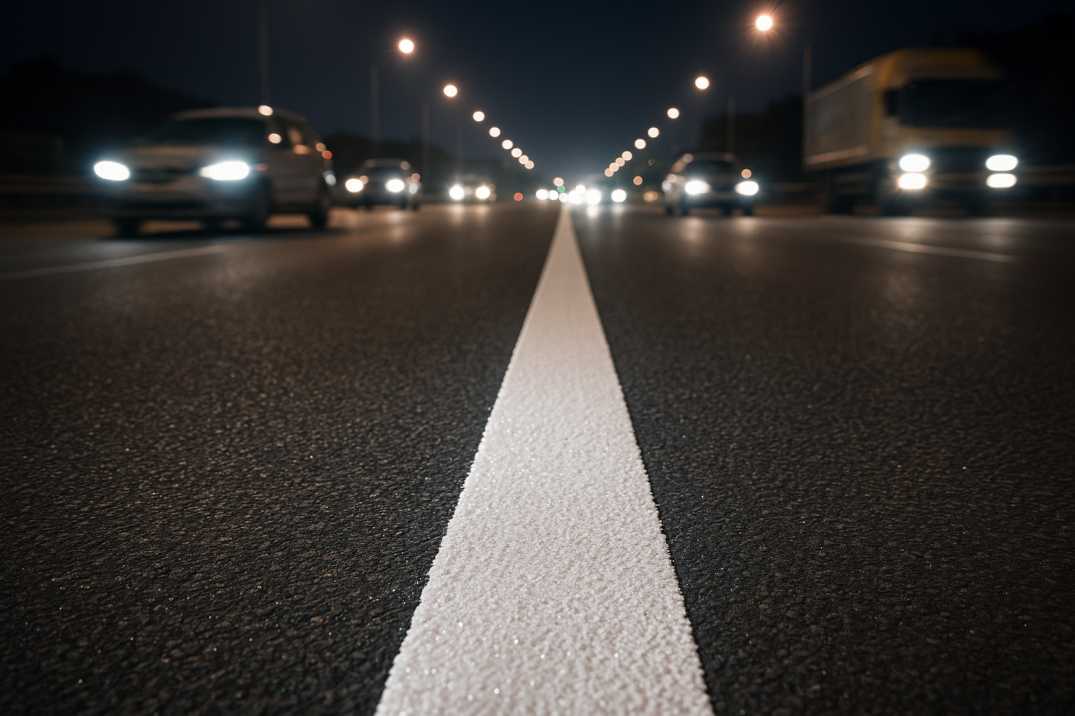Contact Us
RoadVision AI
Private Limited
Office No. 308 & 310, B Block
Ansal Chamber - 1, Bhikaji Cama Place,
Near Engineers India Limited (EIL) Bhawan, New Delhi - 110066
© 2024 | RoadVision AI | All rights reserved
In India, road safety and asset management are governed by guidelines laid out by the Indian Roads Congress (IRC). One of the most important references is IRC 67, which specifies the standards for road markings. These standards play a crucial role in ensuring safe and efficient movement of vehicles across highways, city roads, and rural networks.
When it comes to compliance, authorities and contractors must decide between thermoplastic road markings and conventional paint. While both are recognized under IRC 67, their performance, durability, and cost-effectiveness vary greatly. With the adoption of AI-based durability monitoring and digital road monitoring systems, road authorities in India now have scientific tools to evaluate which solution provides long-term value.

The IRC 67 guidelines define standards for center lines, edge lines, stop lines, directional arrows, pedestrian crossings, and more. These markings are not just visual aids but mandatory tools for road safety. The manual prescribes material requirements, reflectivity, thickness, and visibility during both day and night.
Paint and thermoplastic are the two primary materials allowed, but their compliance depends on durability and reflectance performance. This is where AI-based pavement testing has started to reshape how road authorities evaluate compliance with IRC norms.
Thermoplastic road markings last significantly longer compared to conventional paint. While paint may wear off in 6–12 months depending on traffic load, thermoplastic markings can endure for 2–3 years or more.
IRC 67 emphasizes visibility at night and during adverse weather. Thermoplastic markings provide higher retro-reflectivity because of embedded glass beads, ensuring safer travel. Paint markings, while compliant, lose reflectivity faster under heavy traffic.
Thermoplastic requires heating and specialized machinery, making it more complex but also more precise. Paint, on the other hand, is easier to apply but wears faster.
Paint is cheaper upfront but requires frequent re-application. Thermoplastic is costlier but cost-effective over the lifecycle of the road. With AI-based durability monitoring, agencies can calculate actual lifecycle costs instead of just upfront expenses.
Traditional inspection of road markings under IRC 67 relied on manual surveys and visual assessments. This process often resulted in inconsistent reports and delayed interventions. Today, AI-based durability monitoring and AI-based pavement testing provide accurate, data-driven insights into marking conditions.
Smart sensors, machine vision, and digital road monitoring systems help identify fading reflectivity, cracks, and uneven application. This ensures that corrective measures are taken before the markings fail to meet safety standards.
Road asset management in India is evolving rapidly, with digital tools transforming how highways and city networks are monitored. From road safety audits to traffic surveys, AI provides road authorities with real-time data.
The best AI road asset management company in India not only monitors pavements and markings but also integrates solutions like predictive analytics and lifecycle planning. This holistic approach ensures compliance with IRC rules while optimizing costs and improving safety.
The choice between thermoplastic road markings and paint is no longer just about cost. It is about safety, compliance with IRC 67, and long-term sustainability. With AI-based durability monitoring, road authorities in India now have a reliable way to ensure road markings remain visible, safe, and compliant.
If you want to explore how your projects can benefit from AI-based pavement testing and digital road monitoring systems, connect with us today.
RoadVision AI is transforming infrastructure development and maintenance by harnessing AI in roads to enhance safety and streamline road management. Using advanced roads AI technology, the platform enables early detection of potholes, cracks, and surface defects through precise pavement surveys, ensuring timely maintenance and optimal road conditions. Committed to building smarter, safer, and more sustainable roads, RoadVision AI aligns with IRC Codes, empowering engineers and stakeholders with data-driven insights that cut costs, reduce risks, and enhance the overall transportation experience. Book a demo with us
Q1: Which road marking material is preferred under IRC 67?
Both paint and thermoplastic are allowed, but thermoplastic is preferred for high-traffic roads due to its durability and reflectivity.
Q2: How does AI support durability monitoring of road markings?
AI uses sensors and machine vision to track reflectivity, thickness, and wear, ensuring markings remain compliant with IRC standards.
Q3: Why is thermoplastic more cost-effective in the long run?
Although thermoplastic is more expensive upfront, its extended durability reduces frequent re-application costs, making it economical over time.